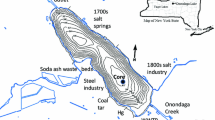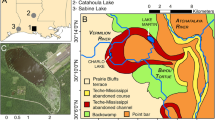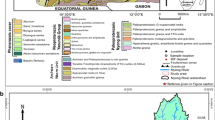Abstract
The chronology of near-surface sediments in Lake Illawarra has been investigated using radiocarbon dating and anthropogenically derived substances including trace metals, ash, and137Cs. Sediments at depths about 1 m below the water-sediment interface ranged in age from Modern to 786 calendar years bp on the basis of radiocarbon dating ofNotospisula trigonella valves. Multiple marker (for example ash-trace metals) depth-concentration sediment profiles yielded estimates of sedimentation rate ranging from 3 to 5 mm yr−1 at Griffins Bay to more than 16 mm yr−1 at Macquarie Rivulet. Sedimentation rates of approximately 10 mm yr−1 appeared to be typical of the western and southwestern portions of the lagoon. Rates of sediment accretion, prior to catchment clearing, urbanization, and industrialization have been estimated at less than 1 mm yr−1, thus indicating a general tenfold increase in sediment accumulation adjacent to the western foreshore caused by catchment development. Accelerated sedimentation in shallow coastal lagoons constitutes significant environmental impacts including shoaling, degradation of seagrass beds, and increased turbidity with consequent loss of aesthetic appeal. Management policy should be directed at attempts to reduce the amount of sediment input by the construction of strategically placed sediment retention ponds. Siltation within the shallow embayments of Lake Illawarra could be ameliorated by a carefully planned program of dredging.
Similar content being viewed by others
References
Aston SR, Bruty D, Chester R, and Padgham RC (1973) Mercury in lake sediments: A possible indicator of technological growth. Nature 241: 450–451
Batley GE (1987) Heavy metal speciation in waters, sediments and biota from Lake Macquarie, New South Wales. Aust J Mar Freshwater Res 38: 591–606
Batley GE, Body N, Cook B, Dibb L, Flemming PM, Skyring G, Boon P, Mitchell D, and Sinclair R (1990) The ecology of the Tuggerah Lakes system. A review: With special reference to the impact of the Munmorah Power Station. Stage 1: Hydrology, aquatic macrophytes, heavy metals, nutrient dynamics. CSIRO-Division of Fuel Technology, CSIRO-Division of Water Resources and Murray-Darling Freshwater Research Institute Investigation Report. 185 pp. (unpublished)
Belperio AP, Smith BW, Polach HA, Nittrouer CA, DeMaster DJ, Prescott JR, Hails JR, and Gostin VA (1984) Chronological studies of the Quaternary marine sediments of northern Spencer Gulf, South Australia. Mar Geol 61: 265–296
Bourg ACM (1988) Metals in aquatic and terrestrial systems: Sorption, speciation and mobilization. In: Salomons W and Förstner U (Eds), Chemistry and biology of solid waste. Berlin: Springer-Verlag, pp 3–32
Chenhall BE, Yassini I, and Jones BG (1992) Heavy metal concentrations in lagoonal saltmarsh species, Illawarra region, south-eastern Australia. Sci Total Environ 125: 203–225
Chenhall BE, Batley GE, Yassini I, Depers AM, and Jones BG (1994) Ash distribution and metal contents of Lake Illawarra bottom sediments. Aust J Mar Freshwater Res 45: 977–992
Clark RL and Wasson RJ (1986) Reservoir sediments. In: De Deckker P and Williams WD (Eds), Limnology in Australia. Melbourne: CSIRO. pp 497–507
Crawford EA, Roy PS, Brooks K, Zamberlan A, Scott T, MacKay NJ, and Chvojka R (1976) Heavy metals in bottom sediments and fish from Lake Macquarie, New South Wales. Geological Survey of New South Wales Report GS 1976/283
Davison W (1993) Iron and manganese in lakes. Earth Sci Rev 34: 119–163
Eliot IG, Young RW, and Clarke DJ (1976) Lake hydrology. In: Young RW, Eliot IG, Jones BG, Harris M, and Turnbull ES (Eds), Illawarra Lake—an environmental assessment project. Wollongong, NSW: Wollongong City Council and The University of Wollongong. pp 41–50
Ellis J and Kanamori S (1977) Water pollution studies on Lake Illawarra. III. Distribution of heavy metals in sediments. Aust J Mar Freshwater Res 28: 485–496
Förstner U and Wittman GTW (1981) Metal pollution in the aquatic environment. Berlin: Springer-Verlag. 486 pp
Frost DJ (1977) Aspects of the clay mineralogy from the catchment area of Macquarie Rivulet, NSW. BSc(Hons) thesis, University of Wollongong, Wollongong (unpublished). 129 pp
Gillespie R and Polach HA (1979) The suitability of marine shells for radiocarbon dating of Australian prehistory. In: Berger R and Suess HE (Eds), Radiocarbon dating. Proceedings of the ninth international conference, Los Angeles and La Jolla. 1976. Berkeley: University of California Press. pp 404–421
Gutteridge, Haskins & Davey Pty Ltd. and the Environmental Protection Agency of Victoria (1981) Characterisation of pollution in urban stormwater runoff. Australian Water Resources Council, Technical Paper 60, Melbourne, Australia. 104 pp
Head J (1990) The radiocarbon dating of freshwater and marine shells. In: Gillespie R (Ed), Quaternary dating workshop 1990. Canberra: Department of Biogeography and Geomorphology, Australian National University. pp 16–18
Heaton B (1982) The effect of salinity on the absorption and desorption of caesium-137 from sediments. In: Third international symposium: Radiological protection—advances in theory and practice, Proceedings vol 1. London: Society for Radiological Protection. pp 126–131
Jones BG, Eliot IG, and Depers AM (1976) Sedimentation in Lake Illawarra. In: Young RW, Eliot IG, Jones BG, Harris M, and Turnbull ES (Eds), Illawarra Lake—An Environmental Assessment Project. Wollongong, NSW: Wollongong City Council and The University of Wollongong. pp 20–40
Kilby GW and Batley GE (1993) Chemical indicators of sediment chronology. Aust J Mar Freshwater Res 44: 635–647
Krumgalz BS, Fainshtein G, and Cohen A (1992) Grain size effect on anthropogenic and organic matter distribution in marine sediments. Sci Total Environ 116: 15–30
Loughran RJ and Campbell BL (1983) The determination of sedimentation depth by caesium 137. Search 14: 157–158
Nanson GC and Hean D (1985) The west Dapto flood of February 1984: Rainfall characteristics and channel changes. Aust Geogr 16: 249–258
Olmez I, Sholkovitz ER, Hermann D, and Eganhouse RP (1991) Rare earth elements in sediments off Southern California: A new anthropogenic indicator. Environ Sci Technol 25: 310–316
Page AL, Elseewi AA, and Straughan IR (1979) Physical and chemical properties of fly ash from coal-fired power plants with reference to environmental impacts. In: Gunther FA (Ed), Residue reviews. Residues of pesticides and other contaminants in the total environment, Vol 71. New York: Springer-Verlag, pp 83–120
Potts PJ, Webb PC, and Watson JS (1984) Energy-dispersive X-Ray fluorescence analysis of silicate rocks for major and trace elements. X-Ray Spectrom 13: 2–15
Roy PS and Crawford EA (1984). Heavy metals in a contaminated Australian estuary—dispersion and accumulation trend. Estuarine Coastal Shelf Sci 19: 341–358.
Roy PS and Peat C (1974) Trace metals in Lake Illawarra. Geological Survey of New South Wales Report GS 1974/319. 7 pp
Roy WR, Thiery RG, Schuller RM, and Suloway JJ (1981) Coal fly ash: A review of the literature and proposed classification system with emphasis on environmental impacts. Illinois State Geological Survey Environmental Geology Notes 96. 69 pp
Smith JD (1982) Lead 210 dating of sediments. In: Ambrose W and Duerden P (Eds), Archaeometry: An Australian perspective. Canberra: ANU Press. pp 303–309
Standards Association of Australia. (1974) AS 1141. Methods for sampling and testing aggregates. Part 31. Light Particles. 2 pp
Stuiver M, Pearson GW, and Braziunas T (1986) Radiocarbon age calibration of marine samples back to 9000 cal yr BP. Radiocarbon 28: 980–1021
Wise S (1980) Caesium-137 and lead-210: A review of the techniques and some applications in geomorphology. In: Cullingford R, Davidson D, and Lewin J (Eds), Timescales in geomorphology. London: John Wiley and Sons. pp 109–127
Yassini I (1986) Algal growth and control in Lake Illawarra. Report to the Lake Illawarra Management Committee. Wollongong, NSW (unpublished). 12 pp
Yassini I and Jones BG (1987) Ostracoda in Lake Illawarra: Environmental factors, assemblages and systematics. Aust J Mar Freshwater Res 38: 795–843
Yassini I, Depers AM, and Caitcheon G (1994) Ash in the sediment. In: Depers AM, Yassini I, and Clarke A (Eds), Recent Sediments in Lake Illawarra: Implications for Management. Wollongong, NSW: University of Wollongong and Illawarra Catchment Management Committee. pp. 34–56
Young RW (1976) Infilling of the lake. In: Young RW, Eliot IG, Jones BG, Harris M, and Turnbull ES (Eds), Illawarra Lake — an environmental assessment project. Wollongong, NSW: Wollongong City Council and The University of Wollongong. pp 10–19
Author information
Authors and Affiliations
Rights and permissions
About this article
Cite this article
Chenhall, B.E., Yassini, I., Depers, A.M. et al. Anthropogenic marker evidence for accelerated sedimentation in Lake Illawarra, New South Wales, Australia. Geo 26, 124–135 (1995). https://doi.org/10.1007/BF00768326
Received:
Accepted:
Issue Date:
DOI: https://doi.org/10.1007/BF00768326




